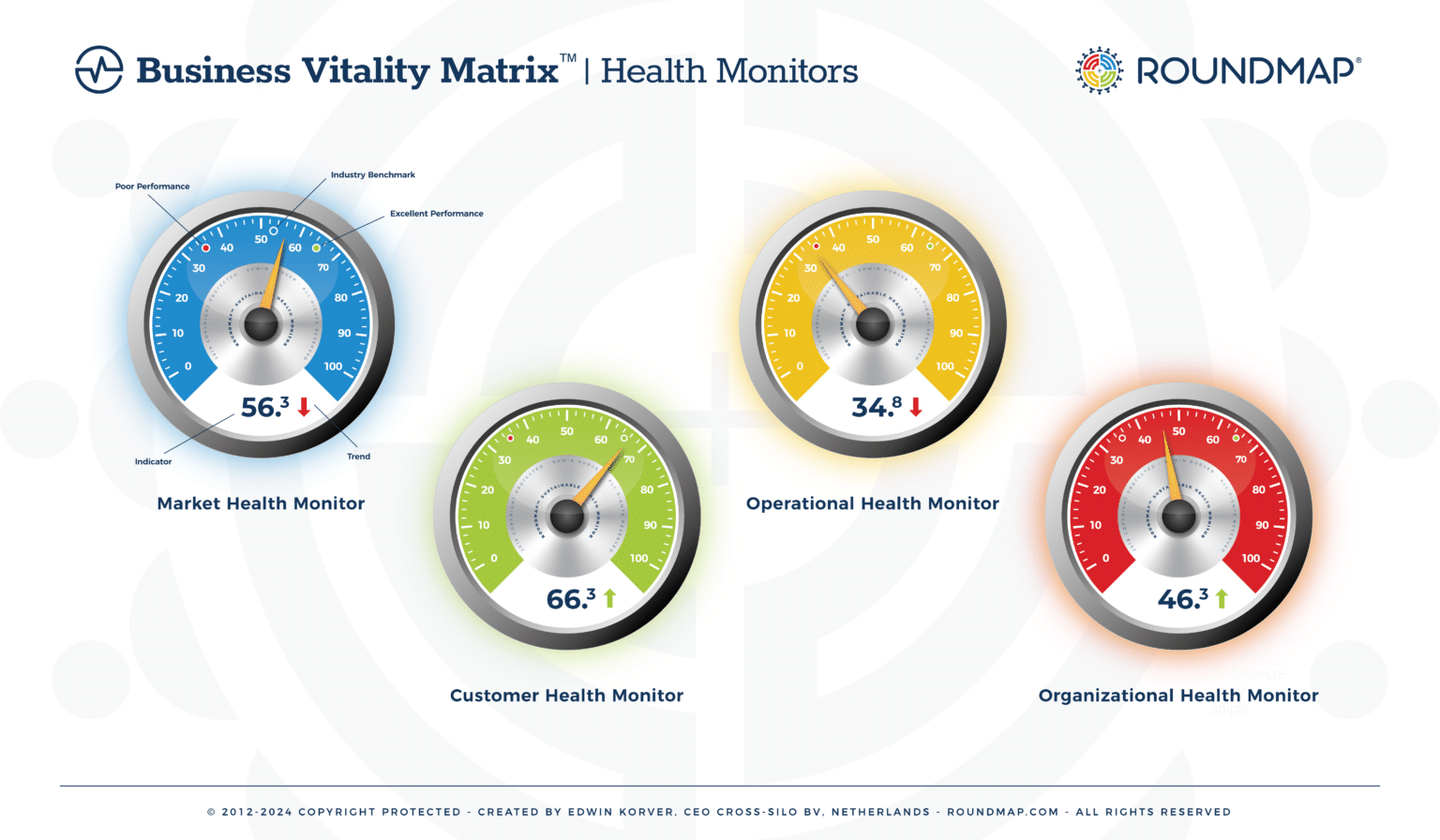In the intricate world of business, success is a journey guided by the delicate interplay of internal and external factors. At its core are four indispensable building blocks—Organizational, Operational, Customer, and Market Dynamics. These dynamics form the bedrock, sculpting the identity and performance of a business enterprise. Together, they navigate the path to prosperity, creating a resilient and thriving business ecosystem.
However, it’s important to note that these dynamics are interconnected, and many elements within a business can be categorized under more than one dynamic. There might be specific nuances or unique aspects of a business that don’t neatly fit into one of these categories. For instance, certain cross-functional initiatives, interdisciplinary projects, or industry-specific considerations may involve elements that draw from multiple dynamics simultaneously.
In essence, the four foundational dynamics serve as a structured framework, but the fluid nature of business operations may result in occasional overlaps or intersections that require a nuanced understanding. Adaptability and a willingness to explore how these dynamics interact can further enhance a business’s ability to navigate complexities and seize opportunities.
The Four Foundational Dynamics
Organizational Dynamics
Cultivating Culture and Strategy
Organizational Dynamics encapsulate the inner workings that shape the soul of a business. This foundational element encompasses:
Corporate Culture: The shared values, beliefs, and behaviors that define the identity of the organization. A strong organizational culture fosters unity, collaboration, and a sense of purpose among employees.
Leadership Style: The approach and philosophy of leaders within the organization. Effective leadership sets the tone, influences decision-making, and inspires teams to achieve common goals.
Strategic Vision: The overarching plan that charts the course for the business. It includes long-term goals, market positioning, and adaptive strategies to navigate changes in the business environment.
Team Dynamics: How teams collaborate, communicate, and innovate. Healthy team dynamics enhance productivity, creativity, and the overall performance of the organization.
Employee Engagement: The level of commitment and satisfaction among employees. Organizational dynamics play a crucial role in creating an environment where employees feel valued, motivated, and invested in the company’s success.
Adaptability: The organization’s ability to respond to change and embrace innovation. A dynamic organizational structure encourages adaptability, ensuring the business stays agile in the face of evolving challenges.
In essence, Organizational Dynamics form the bedrock of a company’s internal environment, influencing how it operates, grows, and adapts to a dynamic business landscape.
Operational Dynamics
Streamlining Efficiency and Adaptability
Operational Dynamics are the gears that drive the day-to-day functions of a business, ensuring it operates smoothly and adapts to changing circumstances. This foundational element includes:
-
Process Optimization: The continual refinement of workflows and procedures to enhance efficiency. Operational dynamics focus on eliminating bottlenecks, reducing waste, and improving overall productivity.
-
Supply Chain Management: The orchestration of the end-to-end process of delivering products or services to customers. Efficient supply chain management minimizes costs, reduces lead times, and ensures product availability.
-
Resource Allocation: The strategic distribution of resources, including human capital, finances, and technology, to maximize output. Operational dynamics involve smart resource allocation to meet business objectives.
-
Technology Integration: Leveraging technology to automate processes, gather data, and enhance decision-making. Operational dynamics embrace technological advancements to stay competitive and agile in the market.
-
Quality Control: Ensuring the consistency and excellence of products or services. Operational dynamics include robust quality control measures to meet customer expectations and regulatory standards.
-
Agility and Flexibility: The ability to adapt to changes in the market or internal environment. Operational dynamics focus on building agile structures that can respond promptly to evolving business conditions.
Operational Dynamics form the operational backbone of a business, ensuring that day-to-day activities run efficiently and adapt to the ever-changing demands of the market and industry.
Customer Dynamics
Building Relationships and Fostering Innovation
Customer Dynamics revolve around understanding, engaging, and satisfying the needs and expectations of customers. This foundational element encompasses:
Customer Relationship Management (CRM): The strategic approach to managing interactions with current and potential customers. CRM systems help businesses build and maintain strong customer relationships.
Market Research: The systematic gathering and analysis of information about customers, competitors, and the market. Customer dynamics involve staying attuned to market trends, preferences, and emerging opportunities.
Customer Experience (CX): The sum of all interactions a customer has with a company throughout the customer journey. Enhancing the customer experience is a key focus of customer dynamics, as positive experiences drive loyalty and advocacy.
Personalization: Tailoring products, services, and communication to individual customer preferences. Customer dynamics leverage personalization to create a more engaging and relevant experience for customers.
Feedback Mechanisms: Establishing channels for customers to provide feedback and actively using that feedback for continuous improvement. Customer dynamics involve listening to customers to understand their needs and expectations.
Innovation through Customer Insight: Harnessing customer feedback and insights to drive innovation. Customer dynamics involve using customer data to identify new opportunities, improve products, and stay ahead of market trends.
Customer Dynamics are integral to creating a customer-centric business, fostering loyalty, and driving innovation based on a deep understanding of customer needs and preferences.
Market Dynamics
Adapting to External Forces
Market Dynamics encompass the external factors influencing a business, guiding its strategies in response to the broader economic environment. This foundational element includes:
-
Competitive Analysis: Evaluating and understanding the strengths and weaknesses of competitors. Market dynamics involve staying aware of competitive forces to position the business effectively.
-
Market Trends: Identifying and capitalizing on emerging trends in the industry. Market dynamics require a keen eye on shifts in consumer behavior, technology, and other factors that shape the market.
-
Regulatory Environment: Navigating and complying with regulations and policies that impact the industry. Market dynamics involve adapting strategies to align with legal and regulatory requirements.
-
Economic Factors: Responding to changes in the economic landscape, such as inflation, interest rates, and overall economic conditions. Market dynamics require businesses to adjust strategies based on economic indicators.
-
Demographics and Consumer Behavior: Understanding the demographics of the target market and predicting consumer behavior. Market dynamics involve tailoring products and marketing strategies to meet the specific needs and preferences of the target audience.
-
Technological Shifts: Embracing and leveraging technological advancements that impact the industry. Market dynamics include staying at the forefront of technology to remain competitive and meet evolving customer expectations.
Market Dynamics necessitate businesses to be proactive in understanding and responding to external forces. By aligning internal capabilities with market trends, businesses can not only survive but thrive in a dynamic and competitive landscape.
The Four Foundational Dynamics Monitors
In our journey to business success, understanding the pulse of our organizational dynamics is pivotal. To provide a comprehensive view, we’ve crafted four monitors, akin to precision gauges, each finely tuned to measure the health of a specific foundational dynamic. These monitors serve as invaluable tools, enabling us to gauge the strength, adaptability, and overall vitality within key dimensions of our business enterprise.
- Organizational Harmony Gauge:
- Purpose: Measures the alignment of values and culture within the organization.
- Indicators: Employee satisfaction, adherence to core values, and the effectiveness of communication channels.
- Goal: To foster a cohesive and inspired organizational culture that resonates with every team member.
- Operational Efficiency Meter:
- Purpose: Assesses the efficiency and adaptability of operational processes.
- Indicators: Workflow optimization, resource utilization, and responsiveness to market changes.
- Goal: To maintain streamlined operations that optimize resources and swiftly adapt to evolving business landscapes.
- Customer Centricity Index:
- Purpose: Evaluate the organization’s focus on customer needs and satisfaction.
- Indicators: Customer feedback, loyalty, and the effectiveness of customer service initiatives.
- Goal: To cultivate a customer-centric approach that fosters lasting relationships and fuels innovation.
- Market Resilience Gauge:
- Purpose: Gauges the organization’s adaptability to external market forces.
- Indicators: Competitor analysis, responsiveness to industry trends, and regulatory compliance.
- Goal: To enhance the organization’s ability to navigate external challenges and seize opportunities in a dynamic market.
These monitors are not mere instruments; they are the compass guiding us through the intricacies of our business landscape. Regular readings from each gauge empower us to make informed decisions, pinpoint areas for improvement, and ensure the sustained health and vitality of our business enterprise. Let the journey to success be illuminated by the insights provided by our Four Foundational Dynamics Monitors.





